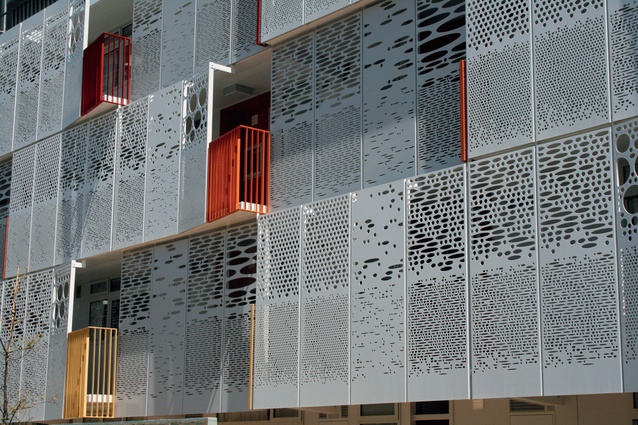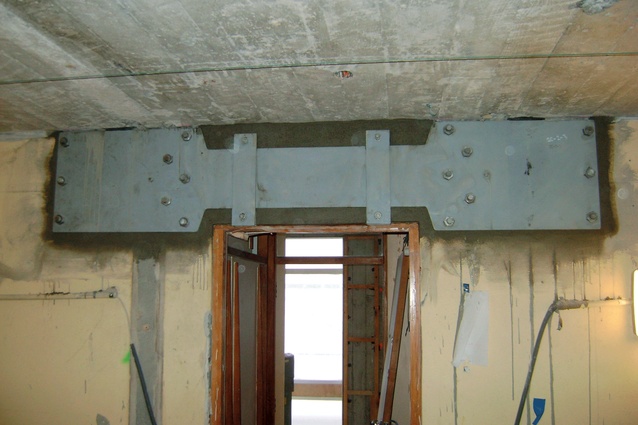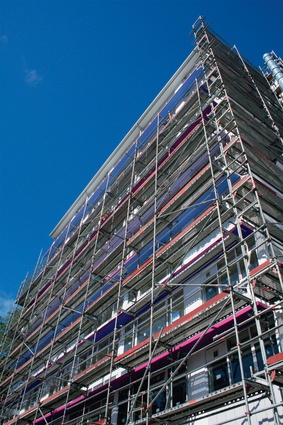Making a comeback
These 1970s Wellington council apartments are undergoing a $37 million seismic and functional upgrade.
What used to be six apartment blocks on the corner of Mansfield Street and Russell Terrace in Newtown, is now five spruced up and earthquake-strengthened buildings and a central car park.
As part of Wellington City Council’s 20-year social housing upgrade, the apartments are being seismically strengthened, refurbished, ventilated, insulated, double glazed and upgraded to meet the latest Building Code requirements. The buildings have gained street appeal as well as functionality and safety.
Attractive perforated screens on the Mansfield Street side have smaller, privacy-sensitive holes in front of doorways while larger holes let sun into bedroom windows. The layout in the two lower-rise buildings has been redesigned to convert bedsits into two-and three-bedroom apartments suitable for families. Throughout the complex there are community spaces for residents where parents can watch children playing from their apartments, vegetable gardens, overall landscaping and consolidated car parking.
Contractor Hawkins Construction, architects from Studio Pacific Architecture, and project engineers Dunning Thornton and BECA, worked collaboratively from the design-development and pre-construction phases of the project. Expecting surprises, the team altered the design and construction methodologies along the way.
While there was no overall architectural redesign, architects, contractors and engineers worked together to solve issues such as installing services within the existing space. “Given the structural capacity of these [in situ concrete] buildings there are some very significant areas in terms of making holes so you can’t just go willy-nilly putting a pipe through here or there,” Studio Pacific Architecture’s Andrew Banks said.

Larger, more robust fire stairs were installed to meet modern standards and the seismic strength of the buildings was brought up to well over 70 per cent, and in some parts, close to 100 per cent of the current seismic requirements. Extensive structural testing indicated the need for earthquake-resilient features. Structural engineer Alistair Cattanach brought together geotechnical and structural engineering knowledge in a way he thought would avoid seismic weaknesses found in other older buildings.
A condition survey of all the buildings resulted in one original block being demolished. The ground is of variable quality; a mixture of clay with harder ground beneath in some areas. Then the issue of 1970s construction was added to the mix. “One [technique] was the old Franki-piles they built back then,” Mr Cattanach said. “They drove the base of the pile in but the reinforcing isn’t bedded in so when you pull on it, it snaps off. We were concerned about that because when the buildings are rocking, you’ve got no hold down.”

The piles were four to eight metres down, depending on their position on site. Under two of the larger blocks, contractors dug beneath the building, cut piles and full-scale load tested. Results from this were used to design so work only had to be done above ground. The three taller blocks proved to be strong transversely, but had a natural weakness longitudinally. “At the end of the buildings the ways the walls terminate are irregular. Because of the type of material they put in the walls there’s a structural weakness.”
This weakness was addressed in several ways. In one block the kink, or dogleg, caused by the irregularities was removed by rebuilding the walls. In another taller block, the kink was evident at both ends so the walls had to be fixed accordingly, and more attention was given to the foundations because of the building’s height. But it was not possible to change the kink in the block that was built first. “We cut the kink off and separated it from the main shear wall so it won’t get any seismic loads, which means the building feels a lot shorter,” Mr Cattanach said.
“We knew what the piles could do but we needed to absorb some seismic energy.” So they cut above every doorway and inserted steel plate ‘ bow ties’, which get damaged in a seismic event as opposed to the concrete breaking.

The low blocks were softened lengthways. “We made a new foundation [drag] beam which is like a big comb. The tines of the comb bend so there’s a new ductile, energy-absorbing foundation beam along the shear walls. The shear walls won’t crack, the foundation beams will absorb energy, and the piles won’t break,” he said.
Other challenges involved structurally enabling the services where there was little excess space without weakening the building, and clipping balconies and screens to different parts of the building. “Our role has been adding energy absorption and robustness to the building where we could, without changing it geometrically, and so enabling the architecture.
Early in the project asbestos was found, as expected in buildings of this age. The buildings were then shut down and sealed off for six weeks while contractors scraped back, washed down and sealed the old ceilings in the lounges, bedrooms and communal corridors. The installation of new stairs presented the main challenge of the project, site manager Shane Beech said. The first time a staircase was installed, it was done from the ground floor up, and hoisted floor after floor. It took 30 to 40 days and a decision was made not to repeat the process.
To install the other fire-compliant stairs, small patches of roof were removed, and the stairs were craned into place in sections, a much faster process that took just five days. By upgrading the different buildings one by one, the project team was able to continue to make efficiencies. “We transferred lessons so that saved us time and redesign costs,” Hawkins contract manager Andrew King said.
The strength of concrete encountered in one block also provided a lesson with which to work in the other blocks. The concrete was harder than expected and contractors spent about nine days breaking it up by hand. Diggers were put in the next building to speed up the process, which was reduced to three days.
The whole upgrade, which started in February 2011, is on course for completion in June. Mr Banks said the project had provided a lot of valuable lessons about concrete structures that could be applied to future upgrade work.














